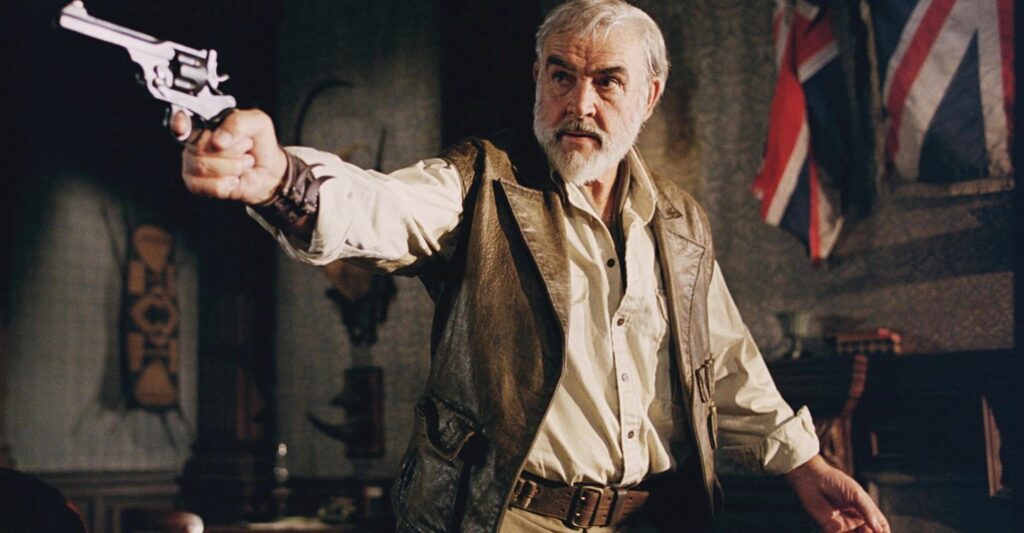
[EDITOR’S NOTE: In 2003, long before MovieManifesto.com existed, I spent my summer as a 20-year-old college kid writing as many movie reviews as I could. My goal was to compile them all into a website, possibly hosted by Tripod or Geocities, which would surely impress all of the women in my dorm. That never happened—neither the compiling nor the impressing—but the reviews still exist. So, now that I am a wildly successful critic actually have a website, I’ll be publishing those reviews on the respective date of each movie’s 20th anniversary. Against my better judgment, these pieces remain unedited from their original form. I apologize for the quality of the writing; I am less remorseful about the character of my 20-year-old opinions.]
Here is a movie that, when all’s said and done, fails to possess an identity. It is unsure whether it is an action blockbuster, a broad comedy, or a glib satire, and so it tries to be all of these at once and winds up being none of them. The League of Extraordinary Gentlemen (or LXG, as it has taken to calling itself) is a rambling, self-destructive journey that ultimately has no purpose. To be sure, it has its moments of genuine imagination, but most of the time it feels woefully uninspired, especially when saddled with such an insipid plot. This is a forgettable mishmash that pretends to be sly and entertaining but is, in reality, just plain dull.
The title of the picture refers to the bizarre assemblage of illustrious individuals snatched from various arenas of classical literature. They include: Captain Nemo (Naseeruddin Shah) and his vessel the Nautilus, of 20,000 Leagues Under the Sea; Mina Harker (Peta Wilson), the lady vampire of Dracula; Skinner (Tony Curran), the Invisible Man; the ageless – and therefore essentially immortal – Dorian Gray (Stuart Townsend) of Oscar Wilde’s novel; Huck Finn’s friend, the gun-slinging Tom Sawyer (Shane West); and Dr. Jekyll and his beastly counterpart, Mr. Hyde (Jason Flemyng). Call it a Cliff’s Notes of the canon.
Of course, such a confederation would be incomplete without the services of James Bond, but apparently the filmmakers couldn’t get the rights for him, so they did the next best thing and cast Sean Connery as Allan Quatermain, who used to accomplish all sorts of impossible feats for the British Empire (sans Aston Martin) before he turned 72 years old and retired to the African wilderness. He and the rest of the league are recruited by a man called M (a sly, though perhaps unintentional, homage to the Bond movies). M (Richard Roxburgh) wants the League to employ its powers to deter the efforts of the Phantom, who’s running around Europe causing chaos with his terrifying futuristic weaponry such as tanks and automatic rifles (the film takes place in 1899).
Or something like that. The plot of LXG is pretty much on autopilot (including the mandatory twist near the finale), which would be fine, if only the actors weren’t too. As it is, things feel listless, with characters languidly delivering their lines as though they’re sleepwalking. Even Connery seems sluggish and uninterested. It doesn’t help that the dialogue by screenwriter James Dale Robinson (working from a graphic novel) is wholly absent both of humor and intelligence, reducing Connery to an absurd scene in which he tutors the young, irritatingly cocksure Sawyer on how to shoot.
The central problem with that scene, as with the rest of the film, is its deadened atmosphere. LXG could have been entertaining if it didn’t take itself so damn seriously. Instead we’re left with a piece that’s moody and sorrowful, a disposition that does not at all suit the farcical nature of the material. The exception to this is the presence of Stuart Townsend, who as Dorian Gray possesses a wry, underhanded drollness that provides a welcome antidote to the melancholy of the rest of the picture. It’s also nice to see a villain as kitschy as The Phantom, with his matted hair and raspy voice; thus it’s a bit disappointing when he is later revealed to be more (or perhaps less) than what he seems.
At least, if nothing else, things sure do look good. Parts of LXG have a gothic, otherworldly feel, and production designer Carol Spier deserves special commendation. Buildings seem to teeter precariously on edge, and city streets feel treacherous and unsafe in flickering lamplight, recalling images of Dark City and Batman. There is also a glorious shot of the Nautilus emerging majestically from the ocean, though it becomes less and less glorious after it is repeated what feels like 20,000 times.
The special effects are also impressive. Director Stephen Norrington and cinematographer Dan Laustsen have devilish fun in photographing the Invisible Man, and there are some terrific moments in which an overcoat is draped over a seemingly nonexistent pair of shoulders and proceeds to meander about on its own. And the gargantuan persona of Mr. Hyde is convincing with the majority of his movements; later a fitting antagonist emerges, also charismatically repulsive in his grotesque muscularity.
This eye-candy is all well and good, but we must remember that LXG is essentially a B-movie with an A-level budget, and the noteworthy visuals can distract us from the failings of the screenplay and plotting for only so long. In the end, it is the film’s lack of warmth and frivolity that proves to be its undoing. Far from being extraordinary, LXG is a clunky, overweight bore.
Jeremy Beck is the editor-in-chief of MovieManifesto. He watches more movies and television than he probably should.

Another one that I remember the experience of going to see it, but not the film itself. I’ve had the vague sense that it wasn’t so bad as people made out, but not enough so as to make me watch it again and check.
Yeah, I’ve been rewatching a bunch of summer ’03 movies for a project, but my desire to revisit this one is… limited.